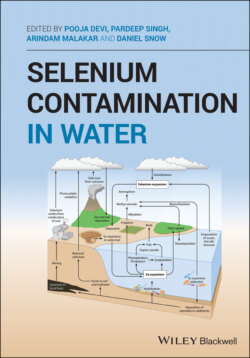Читать книгу Selenium Contamination in Water - Группа авторов - Страница 16
1.2 Selenium Reduction Technologies Used in India
ОглавлениеPhytoremediation is a technology in which selenium get accumulated in plant parts and then plants can be harvested and incinerated. Phytovolatilization, which is also a type of phytoremediation, is more effective, in which a few plant species which can tolerate selenium can be grown on selenium‐contaminated sites and then can volatilize less toxic forms or non‐toxic forms of it in the environment (Dhillon and Dhillon 2003). This technique efficiently remediates soils contaminated with selenium as well as being an eco‐friendly technology and using fewer resources.
In Punjab, mustard is found to be the best accumulator of selenium. It is may be because of the high concentration of sulfur in mustard and the resemblance of selenium to sulfur. In addition to mustard, other plants, including onion, garlic, broccoli, Brazilian nuts, and mushroom, also show a strong affinity to Se (Sharma et al. 2015). In soil systems, many remediation methods can be applied for selenium management, such as gypsum application in selenium‐contaminated farms, which has been found to be efficient in its reduction levels (Dhillon and Dhillon 2000). Application of organic matter such as press mud and poultry manure has shown to reduce Se levels in rice, wheat, and maize up to 97% in Se‐contaminated farms (Dhillon et al. 2010). In situ bioremediation can be achieved by bacterial cultures belonging to b‐Proteobacteria and Bacilli class, which are fairly selenium‐tolerant microorganisms (Ghosh et al. 2008; Prakash et al. 2010).
Figure 1.5 Upper panel: word dynamics for India. Lower panel: word dynamics for China.
Biofortification, in which harvested plant parts are decomposed in agricultural soil which can be used further for the enrichment of food products with Se (Bañuelos et al. 2015), is another method.
Among the other technologies being used for the remediation of selenium‐contaminated waters are: ion exchange, reverse osmosis, nanofiltration, solar ponds, chemical reduction with iron, microalgal–bacterial treatment, alumina adsorption, Fe+3 coagulation/filtration, lime softening, and ferrihydrite adsorption (El‐Shafey 2007; Luo et al. 2008). Use of waste wheat bran can be an eco‐friendly technology in a continuous up‐flow fixed‐bed column system for biosorption of selenium species in aqueous solution (Hasan et al. 2010). One of the efficient methods of selenium removal from waste water can be use of double‐layered synthetic hydroxide materials (Zn/Al, Mg/Al, and Zn/Fe) as an adsorbent (Mandal et al. 2009).
Another technology demonstrates photoreductive removal of selenium (IV) using spherical binary oxide photo catalysts under visible light. As a range of scavengers, EDTA (ethylene diamine tetra acetic acid) and formic acid are found to be the most suitable for the reduction reaction, and of these two, formic acid is found best for reduction of selenium – the catalyst used for the process is TiO2, which is non‐corrosive, non‐toxic, and has high photoactivity, high photostability, and an economical nature. It has been reported that catalyst can be used repeatedly at least five times with marginal change in the activity (Aman et al. 2011).
